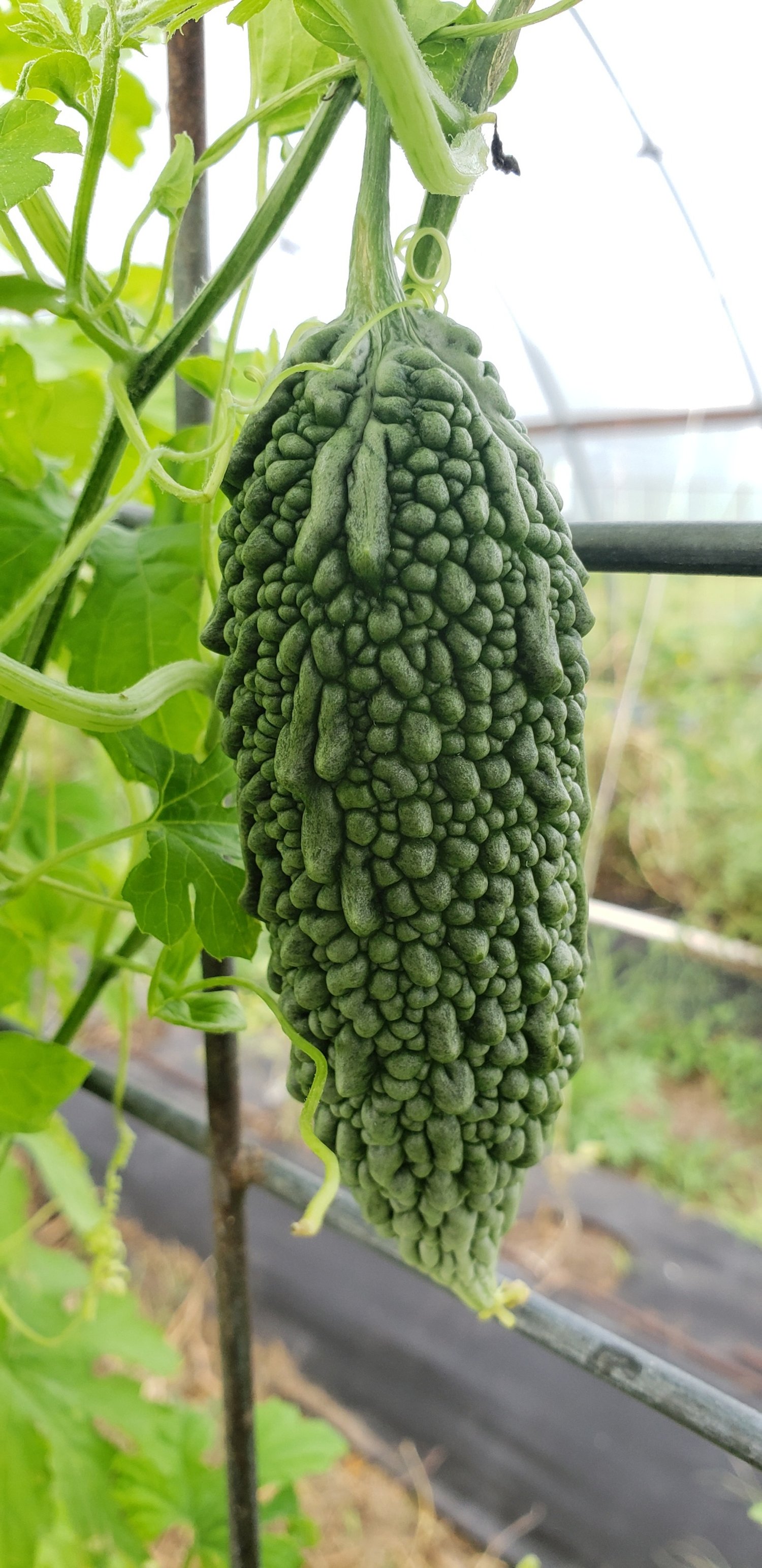Bitter Melon Seeds
Listing is for a Large Pack of 30+ "Abashi" bitter melon Momordica charantia seeds for your garden or homestead. Grow these throughout spring and summer and into the fall.
Very useful plant, grows vigorously here in South Texas throughout our 105° days without a problem.
Here's some snipits of information about this powerful plant.
Seasonality
Bitter melon are tropical plants, and are generally in season in local markets in the warm summer months. You may be able to find them year-round in Asian and Indian markets (flown in from far-flung areas).
Cultivation
Bitter melon is the fruit of Momordica charantia,a tropical plant in the Cucurbit (cucumber) family. The plants do best in hot and humid environments. Like other members of the Cucurbit family, the plants are vining in habit, and can grow up to 16 feet long. The fruit looks like a warty cucumber, some with tapered ends, and the leaves are large and deeply lobed. Like its cousins, cucumbers and melons, it does well on sturdy trellises (with the added bonus that trellising the plant makes the fruit easier to harvest).
As the fruit matures, it turns from light or dark green (depending on the variety) to deep yellow, and at full maturity will split from the bottom, revealing bright red, pulpy seeds.
Eating Bitter Melon
Storing
Store the fruit in the refrigerator in the crisper drawer in a paper or plastic bag for three to five days.
Cooking
The flesh and peel, as you may have guessed, is extremely bitter. Some recipes call for removing the peel (which can be somewhat waxy in certain varieties and also may hold onto pesticide residue).
You can reduce bitter melon’s bitterness by blanching it first and then cooking with it, but some say that this affects the fruit’s texture in a negative way. Salting it first (like with eggplant) can also reduce its bitter flavor.
Look to Southeast Asian, Chinese, Japanese (especially Okinawan) and Indian cuisine for recipes.
Listing is for a Large Pack of 30+ "Abashi" bitter melon Momordica charantia seeds for your garden or homestead. Grow these throughout spring and summer and into the fall.
Very useful plant, grows vigorously here in South Texas throughout our 105° days without a problem.
Here's some snipits of information about this powerful plant.
Seasonality
Bitter melon are tropical plants, and are generally in season in local markets in the warm summer months. You may be able to find them year-round in Asian and Indian markets (flown in from far-flung areas).
Cultivation
Bitter melon is the fruit of Momordica charantia,a tropical plant in the Cucurbit (cucumber) family. The plants do best in hot and humid environments. Like other members of the Cucurbit family, the plants are vining in habit, and can grow up to 16 feet long. The fruit looks like a warty cucumber, some with tapered ends, and the leaves are large and deeply lobed. Like its cousins, cucumbers and melons, it does well on sturdy trellises (with the added bonus that trellising the plant makes the fruit easier to harvest).
As the fruit matures, it turns from light or dark green (depending on the variety) to deep yellow, and at full maturity will split from the bottom, revealing bright red, pulpy seeds.
Eating Bitter Melon
Storing
Store the fruit in the refrigerator in the crisper drawer in a paper or plastic bag for three to five days.
Cooking
The flesh and peel, as you may have guessed, is extremely bitter. Some recipes call for removing the peel (which can be somewhat waxy in certain varieties and also may hold onto pesticide residue).
You can reduce bitter melon’s bitterness by blanching it first and then cooking with it, but some say that this affects the fruit’s texture in a negative way. Salting it first (like with eggplant) can also reduce its bitter flavor.
Look to Southeast Asian, Chinese, Japanese (especially Okinawan) and Indian cuisine for recipes.
Listing is for a Large Pack of 30+ "Abashi" bitter melon Momordica charantia seeds for your garden or homestead. Grow these throughout spring and summer and into the fall.
Very useful plant, grows vigorously here in South Texas throughout our 105° days without a problem.
Here's some snipits of information about this powerful plant.
Seasonality
Bitter melon are tropical plants, and are generally in season in local markets in the warm summer months. You may be able to find them year-round in Asian and Indian markets (flown in from far-flung areas).
Cultivation
Bitter melon is the fruit of Momordica charantia,a tropical plant in the Cucurbit (cucumber) family. The plants do best in hot and humid environments. Like other members of the Cucurbit family, the plants are vining in habit, and can grow up to 16 feet long. The fruit looks like a warty cucumber, some with tapered ends, and the leaves are large and deeply lobed. Like its cousins, cucumbers and melons, it does well on sturdy trellises (with the added bonus that trellising the plant makes the fruit easier to harvest).
As the fruit matures, it turns from light or dark green (depending on the variety) to deep yellow, and at full maturity will split from the bottom, revealing bright red, pulpy seeds.
Eating Bitter Melon
Storing
Store the fruit in the refrigerator in the crisper drawer in a paper or plastic bag for three to five days.
Cooking
The flesh and peel, as you may have guessed, is extremely bitter. Some recipes call for removing the peel (which can be somewhat waxy in certain varieties and also may hold onto pesticide residue).
You can reduce bitter melon’s bitterness by blanching it first and then cooking with it, but some say that this affects the fruit’s texture in a negative way. Salting it first (like with eggplant) can also reduce its bitter flavor.
Look to Southeast Asian, Chinese, Japanese (especially Okinawan) and Indian cuisine for recipes.


